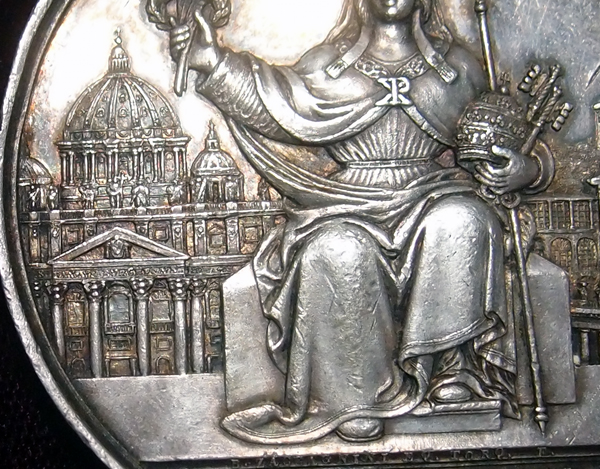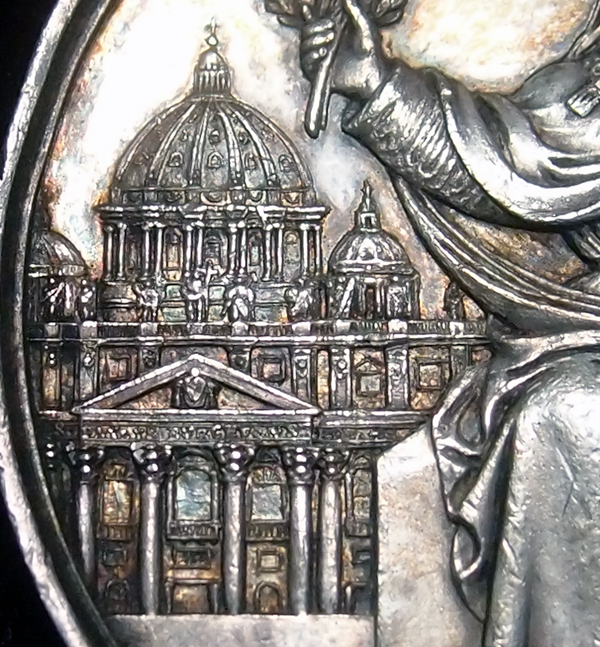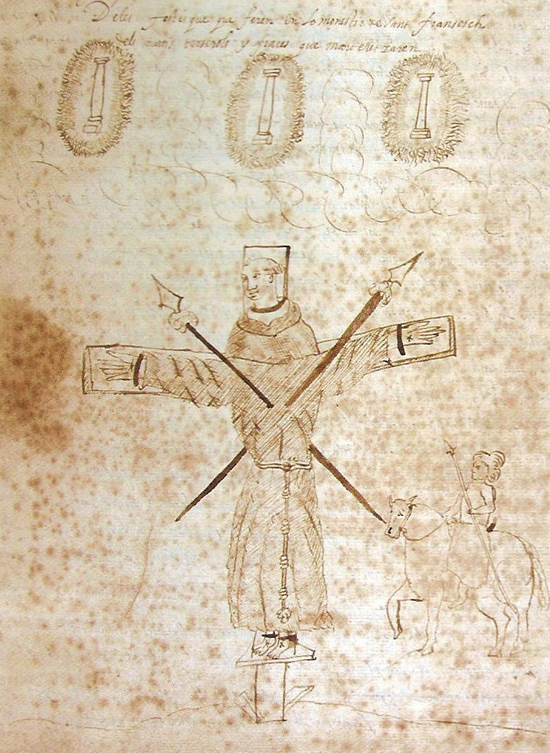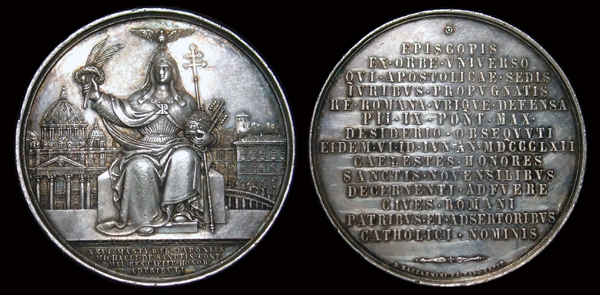
SILVER PAPAL MEDAL - CANONIZATION OF THE TWENTY SIX JAPANESE MARTYRS AND MICHAEL DE SANCTIS
Year: 1862
This silver Papal State medal was minted under Pope Pius IX by the prolific and talented Bonfiglio Zaccagnini in 1862 for the canonization of Michael de Sanctis and the 26 martyrs of Nagasaki Japan.
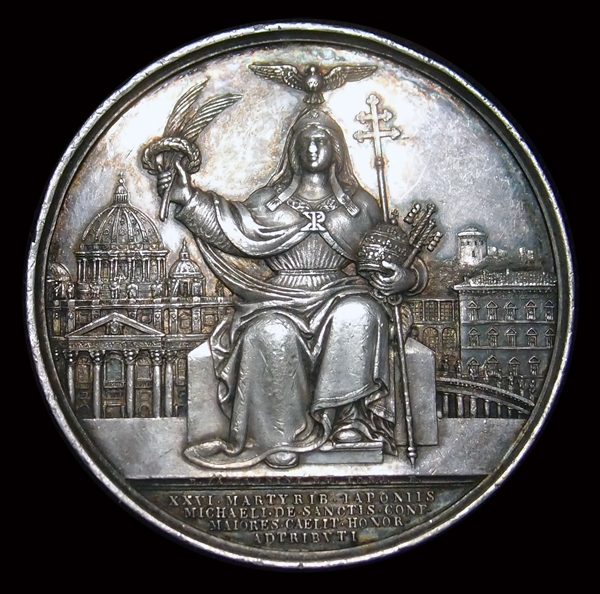 |
Depicted on the Obverse is a Female Allegorical figure of the church, seated on a throne, holding two palms and a martyr's crown in her right hand, papal cross, tiara and a key in her left hand. She wears a cloak with a Chi Rho monogram (christogram), representing the first two letters of the name of Christ in Greek XP. The Holy Spirit is above her in the form of a dove. In the background are intricately detailed buildings in Rome such as St. Peter's Basilica and the Vatican Palace among others. B. Zaccagnini EQ. TORQ. F. just below the feet and above inscription.
 |
Inscription: XXVI MARTYRIB IAPONIIS MICHAELI DE SANCTIS CONF MAIORES CAELIT HONOR ADTRIBVTI / Full divine honors have been accorded to the 26 Japanese martyrs and to the monk Michael de Sanctis
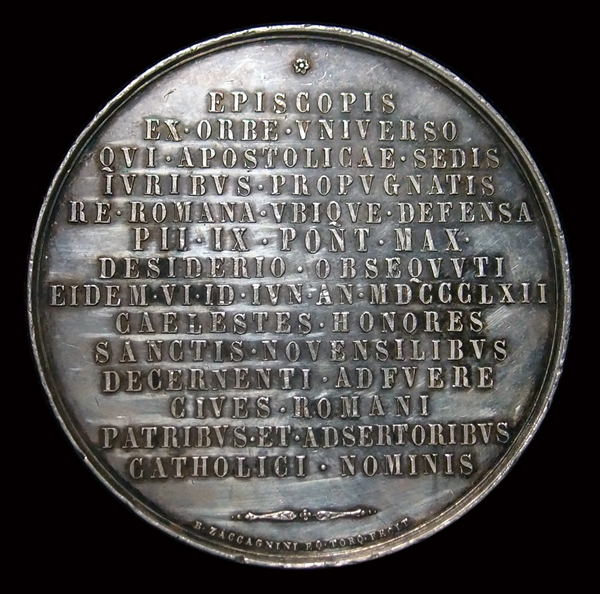 |
Depicted on the Reverse is a 14 line Latin inscription announcing the Canonization of the the Martyrs of Japan and Michael de Sanctis with a rosette above and the signature of the engraver B. Zaccagnini below.
 |
Inscription: EPISCOPIS EX ORBE VNIVERSO QVI APOSTOLICAE SEDIS IVRIBUS PROPVGNATIS RE ROMANA VBIQVE DEFENSA PII IX PONT MAX DESIDERIO OBSEQVVTI EIDE M VI ID IVN AN MDCCCLXII CAELESTES HONORES SANCTIS NOVENSILIBVS DECERNENTI ADFVERE CIVES ROMANI PATRIBVS ET ADSERTORIBVS CATHOLICI NOMINIS (SMALL: B ZACCAGNINI RQ TORQ PROIT)
The citizens of Rome (render homage to) the bishops from all over the world, fathers and protectors of the Catholic name, who, after defending the rights of the papacy and everywhere acting as advocates of Roman Catholic affairs, heeded the summons of Pope Pius IX and, on June 8, 1862, attended his conferment of heavenly honors upon the newly-elevated saints.
|
Twenty-six Martyrs of Japan: Christianity was brought to Japan in 1549 by Francisco Xavier, Cosme de Torres and Father John Fernandez. With hopes of beneficial trade relations with Europe through Spain and Portugal, some of the ruling parties in feudal Japan, particularly Shimazu Takahisa, the daimyo of Kagoshima, who was in favor of opening up relations with foreign powers. He reluctantly agreed to allow Jesuits, and later Franciscans, to build missions over the objections of some who expressed suspicions of foreigners and their motives and the influence they would have on this somewhat isolated culture. In less than 50 years there were hundreds of thousands of Christians in Japan.
After what isknown as the San Felipe Incident in 1596, when the Spanish ship San Felipe was shipwrecked on the island of Shikoku, the daimyo Chosokabe Motochika seized the cargo of the ship and during questioning by the ruling taiko, Toyotomi Hideyoshi, the pilot of the ship informed the Japanese that the Spanish had used missionaries to infiltrate a country before they began military conquest, as had been done in the Americas and the Philippines.
By the end of the century there was a growing mistrust of the west, the church, its intrigue, and the growing ranks of Japanese converts. The religion spread fast and its new converts took to it zealously. After the San Felipe Incident the religion was eventually suppressed for periods of time and at varying degrees. Considered among the first of what would become a growing number of persecutions was the execution of six monks and 20 converts (some as young as 12 years old) on the orders of the daimyo Toyotomi Hideyoshi on the 5th of February in 1597 at Nagasaki. Pope Gregory XIII had expressed reservation when the missionaries requested leave to go to Japan as he knew the evolving state of affairs there and the growing view that missionaries and westerners were increasingly being viewed as interlopers.
Along with the 20 Fransiscan Japanese converts, members of the Third Order of St. Francis, were three Jesuits, Paul Miki, John de Goto and James Kisai. They were marched to Nagasaki, pierced with spears and crucified on crosses. During these purges, missions and homes were destroyed and Christians were crucified. Lists were collected of all Christians and efforts were made to purge that population, driving them to secrecy and going underground out of fear for their lives. Of the Japanese coverts who lost their lives, little is known, however those who survived reported that several of the Japanese martyrs were killed for simply attempting to help the Christians as they were being led to their deaths and there were two boys, 11 and 13 years of age, who against the pleading of their parents joined the Christians and were put to death with them.
It was reported that they were joyous at their death and exhibited brave resolve in their faith meeting the end without fear. Cloth from their garments were gathered and it was reported that they worked miracles. For their ultimate sacrifice for their faith they were canonized by Pope Pius IX in 1862.
Drawing by Miquel Parets in his chronicle for remembering the martyrdom of 26 Catholics crucified in Nagasaki Japan. Parets described the sentence that was applied as it was explained to the people: "And all they together were crucified with hands, feet and necks tied with rings, and were stuck with two spears each one, as indicated in this drawing. And during the martyred three columns of fire appeared in the air." |
Michael de Sanctis: Born September 27, 1591 at Vich, in Spanish Catalonia, Michael decided very early in life to be a monk, taking his vows in 1607 at the age of 15. He regularly subjected himself to harsh self discipline, wore a hair shirt, scourged himself and fasted up to a week at a time. He joined the Discalced Trinitarians eventually serving as superior of this sect at the Valladolid monastery. He devoted his life to prayer, discipline, to the holy trinity, the Eucharist and he is said to have been rapt in ecstasy several times during Consecration.
He died on April 10, 1625 and he is held up as an example of a saint in life, absolutely devoted to god. He was beatified by Pope Pius VI on May 24, 1779 and Canonized June 8, 1862 by Pope Pius IX. The canonizations took place during a large meeting of the higher clergy in Rome, which was attempting to formulate a response to the seizure of the Papal States in 1860.
Bonfiglio Zaccagnini was born in 1739 at Chieti, a small town in Central Italy, about 124 miles east of Rome in the Abruzzo reagion. As a young man he studied in the seminary until moving to Rome with his father. There he was training as an engraver of typographic plates and also learned the art of engraving for coinage showing a considerable talent for this craft.
He was eventually hired by the Papal Mint and chosen to engrave the 1853 annual papal medal of Pius IX. Although a large amount of his output was religious in nature he was described as a man with a character not very adherent to the moral of the time which often found him at odds with his superiors and may have precluded him from greater success in his career.
Zaccagnini died in Rome on October 28, 1867. He was a very talented and highly prolific engraver and carver of cameos and leaves behind an extensive and impressive body of work.
 |

